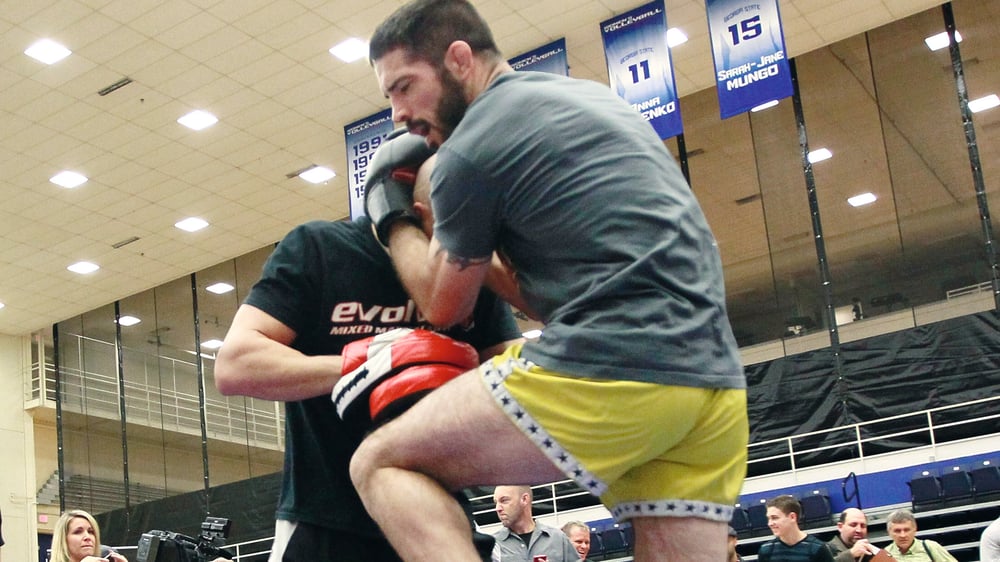
Issue 101
May 2013
After two decades of combat, ‘The Irish Hand Grenade,’ Marcus Davis, shares with FO his perfect pre-fight preparation for the final hours before a fight.
Around 20 years ago, when I first started my professional fight career, inside the boxing ring, very little sports science was involved in the fight game. Whether it was actual fight technique, sports nutrition or even managing the dehydration of the body to make weight; the industry had hardly moved on in a century. However, now we’re in the year 2013, man, how things have changed.
Everyone is studying the human anatomy to make techniques better and intently examining nutrition to fuel a fighter more efficiently to ensure top performance, whilst at the same time cutting caloric intake to drop pounds before the all-important weigh-ins. So much has changed since 1993.
But, in my first in a series of articles for Fighters Only this year, what I am going to address is the pre-fight warm-up. Are the final few hours before a fight that important? Is it really necessary to analyze the final few minutes? Does it truly help, and if it does, what are the benefits? And if indeed there are benefits, what kind of pre-fight warm-up should a combative athlete be undertaking?
After two decades of professional competition, this is my take on the final hours of pre-fight preparation – and the routines that I’ve developed to ensure all the cylinders are firing when the cage door finally closes.
The stretch
People often get confused regarding the benefits of certain parts of your warm-up, but as a rule, stretching should always come second. People, in general, will stretch before they start to warm-up. We’ve all seen it: a fighter stretches out then starts warming up on the heavy bag, hitting mitts or shadow boxing.
But studies have found that warming up by itself will have no effect on your range of motion unless any warm-up is followed by stretching. Not stretching then warming-up, but warm-up then stretch. Then and only then is there an increase in range of motion.
Most people are confused in this area and think that stretching before exercise prevents injuries, even though all clinical research suggests otherwise. A better way to think of it is the warm-up prevents injury, whereas stretching has no effect on range of motion alone or in the prevention of injury.

The mental
Your warm-up is also a perfect way to get your CNS (central nervous system) firing off, connecting the mental and the physical. It helps clear your mind, and you can use it to review your strategy mentally then physically.
When the warm-up involves the techniques and strategy you’ve been working on, it will prepare you to do what you’ve trained to do. Whilst doing the warm-up and performing said strategies and techniques this is a great time for positive imagery that can both relax the fighter and build focus.
With a great warm-up, you are likely to go all-out in your fight and execute your game plan, better self-correct any technical points that may be needed for the fight and also possibly prevent an injury.
What you need to remember is: if you do not feel like you, and your body doesn’t feel ready or prepared, then it’s because most likely you’re not. You need to listen to your body and either continue the warm-up with gradual intensity, or knock it back.
The science
When you warm-up, you start to increase muscle temperature. When your muscles are warm it improves muscle elasticity and when properly done they contract forcefully and relax quickly.
This is the way speed, strength and power can be enhanced. Because the warm-up is before the stretch, the probability of overstretching a muscle and causing injury is far less.
Now your blood vessels dilate which then reduces the resistance of blood flow, which allows that needed red stuff to your muscles. Because this warm-up has increased the temperature of your blood, the binding of oxygen to hemoglobin weakens so oxygen is more available to your working muscles and improves your endurance.
Another great benefit of the warm- up is that when the physical and the mental aspects come together you have actual hormonal changes. Your body increases its production of hormones that are responsible for regulating your energy production. This means more of the carbohydrates and fatty acids you’ve taken in from your pre-fight meals are available for energy production.
Stick with this regimen for preparation and you’ll be ready to make that walk, do what you do, and return to the locker room with the all-important ‘W’.

‘The Irish Hand Grenade’s’ ultimate warm-up
Movement
Basic footwork drills to get my body moving.
Flow work
I will spend 10 minutes moving around with my hands up doing visualization training and going over the plan.
Explode
I will walk around the room calmly then out of nowhere jump as high as I can, pulling my knees to my chest. I will continue this as everyone looks at me like I’m nuts. This will go on for
three to five minutes.
Imaginary sparring
I start moving around both standing and on the ground, going through the motions I’ve been working on in camp. I’m making the mental and physical connections to have my mind sharp and body ready. I will spend at least 10 minutes doing this.
Stretch
Allowing my heart rate to go back down, I thoroughly stretch out my body. Everything that can be stretched will be. I will spend a minimum of 15–30 seconds on a stretch and do said stretch as part of three sets.
Pads, pummel and grapple
Finally, I go to the type of training I’ve been doing throughout the camp. I’ll do two and a half minutes of pads, followed immediately with two and a half minutes of clinch wrestling work, followed immediately by two and a half minutes of groundwork with a partner – the entire time visualizing the fight and myself executing the fight plan perfectly.
...









